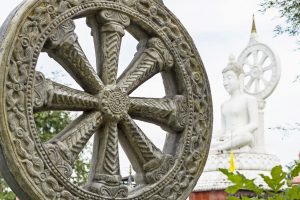“To a large extent, whether you suffer depends on how you respond to a given situation.” — Dalai Lama XIV
Suffering is a universal experience, whether it be a minor inconvenience or the greater types of suffering that plague a lifetime. Through learning the Buddha’s teachings of dukkha, the different types of dukkha, and how to be liberated through The Buddha’s Four Noble Truths, we can hope to understand the truth of suffering and begin letting go of the painful cycles we find ourselves in.
Key takeaways
- Defining dukkha: Understand the Buddhist concept, the seven states of dukkha, and how dukkha relates to the three marks of existence.
- Learn the Buddha’s Four Noble Truths: Discover Buddha’s teachings about the turning of the wheel of Dharma following his enlightenment
- Be inspired by the lotus: Uncover the Buddhist analogy of the lotus rising from the mud and how it applies to suffering.
- Adapt the teachings: Learn how the ancient concepts of dukkha and the path to enlightenment can be applied to modern-day clinical psychology.
The meaning of dukkha
In Pali (the ancient language of Theravada Buddhist scriptures), the word dukkha is translated as suffering. However, it is more commonly understood to mean unsatisfactoriness.
Suffering is often connected with severe or grand conditions, whereas the term dukkha is about the full breadth of the spectrum. For example, dukkha means disappointment, unease, or inconvenience, and it also means detrimental struggles or death. That’s why unsatisfactoriness is a more accurate interpretation as dukkha encompasses all forms of suffering.
What are the 3 marks of existence?
The Three Marks of Existence, also known as the Three Characteristics, are fundamental concepts in Buddhism that describe the nature of all existence and beings. The Buddhist belief is that delusion and ignorance of these characteristics result in suffering. The Three Marks of Existence are:
- Sankhara-Dukkha (Suffering): As explained, dukkha represents the inherent unsatisfactoriness and suffering of existence.
- Sankhara-Anicca (Impermanence): Anicca represents the transient and ever-changing nature of all things—that everything is in a constant state of flux.
- Sankhara-Anatta (Non-self): Anatta is the absence of a permanent, unchanging self or soul. That there is nothing that can be one’s self and that the sense of self is a form of clinging and attachment to something that is impermanent.
What are the 7 states of dukkha?
Dukkha covers the many aggregates of suffering and encompasses a range of human experiences:
- Birth (Jati Dukkha): Birth is one of the kinds of dukkha because of the suffering and challenges that come from the process of birth and the introduction of humans to the cycle of existence, with all its potential for suffering.
- Old Age (Jara Dukkha): Buddhism teaches that aging is a form of suffering. As people grow older, their bodies inevitably experience decay, loss of vitality, and susceptibility to illness and physical limitations.
- Sickness (Vyadhi Dukkha): Illness and physical pain are considered manifestations of dukkha. The experience of sickness can be inconvenient, painful, and detrimental to one’s well-being.
- Death (Marana Dukkha): Death is considered one of the most fundamental aspects of dukkha. It is a manifestation of the impermanence of life and many struggle with the inevitability of death. Buddhists believe in samsara, which is the endless cycle of birth, death, and rebirth. Based on this premise, the avoidance of death and clinging to life is seen as unnecessary suffering and fighting against a natural cycle.
- Sorrow (Soka Dukkha): This form of dukkha focuses on the suffering that comes from the transient and unpredictable nature of existence. This can include the disappointment experienced when things don’t go as planned, the dissatisfaction from unmet dreams or the discomfort from unexpected shifts in circumstances (the Pali term is viparinama-dukkha, the suffering of change).
- Lamentation (Parideva Dukkha): Lamentation refers to the expression of grief and mourning that results from suffering and loss. This could be the loss of something cherished or the loss of a loved one. It reflects the human tendency to dwell on the negative aspects of experience and impermanence of life.
- Despair (Domanassa Dukkha): Despair or mental anguish arises from the sense of hopelessness and helplessness of suffering. It reflects the challenges individuals face in coping with adversity.
The Buddha’s Four Noble Truths
At the age of 35, after meditating under the Bodhi tree for 49 days, Siddhartha Gautama reached enlightenment and became the Buddha (the Pali term for one who discovers the liberating path of Dhamma).
After his enlightenment, the Buddha gave his first discourse on the five ascetics he had practiced with, known as “The turning of the wheel of Dharma.” These teachings include The Four Noble Truths, which stand as the cornerstone of Buddhist philosophy and practice.
This marked the beginning of his teaching journey and served as guidance towards understanding the nature of human existence and how to transcend suffering.
Want to learn more about the Buddha’s awakening? Mal Huxter tells the story of Siddhartha Gautama’s journey.

- Mud & Lotuses: Talk 1 From A 10-Day Silent Meditation Retreat Mal Huxter 38:14
The Buddha’s first discourse
The Buddha walked from what is now known as Bodhgaya to Sarnath (then known as Isipatana, a small town near Varanasi in northern India). The Buddha sought to share his profound realizations with the five ascetics, who had previously followed him for six years during his austere practices.
They were initially wary of the changes in Siddhartha and reluctant to welcome him back. The ascetics believed that turning his back on his devotion to austerities meant he had given up on his search for enlightenment and his word could not be trusted. However, upon reuniting, his enlightenment was clear.
He was greeted warmly, and they embraced the teachings of “The turning of the wheel of Dharma” that he shared with them. These teachings were the Dhammacakkappavattana Sutta, also known as the Buddha’s First Discourse.
In his discourse, the Buddha introduced the concept of the Middle Way. This taught the importance of avoiding extremes—both indulgence and severe asceticism.
In his discourse, the Buddha introduced the concept of the Middle Way. This taught the importance of avoiding extremes – both indulgence and severe asceticism. The Middle Way presented a balanced approach to life and spiritual practice, advocating for moderation and mindfulness in all aspects of existence. Building on this foundation, the Buddha explained the Four Noble Truths, the basis for understanding the nature of suffering, its cause, its cessation, and the path to liberation.
There are these two extremes that are not to be indulged in by one who has gone forth. Which two? That which is devoted to sensual pleasure with reference to sensual objects: base, vulgar, common, ignoble, unprofitable; and that which is devoted to self-affliction: painful, ignoble, unprofitable. Avoiding both of these extremes, the middle way realized by the Tathagata — producing vision, producing knowledge — leads to calm, to direct knowledge, to self-awakening, to Unbinding.
First Noble Truth
The First Noble Truth is the acknowledgment and understanding of dukkha. Theravada Buddhism (one of the oldest and most traditional forms of Buddhism) emphasizes that the very nature of existence is impermanent and unsatisfactory.
The Buddha taught that the origin of dukkha comes from birth, aging, illness, death, separation from loved ones, and not getting what one desires. All of these are certain parts of existence, therefore making dukkha unavoidable. Accepting the reality of dukkha is the first step on the path towards liberation from suffering.
Second Noble Truth
The Second Noble Truth in Buddhism focuses on the roots of dukkha. It is believed that the nature and origin of suffering and unsatisfactoriness are craving (tanha) and attachment (upadana).
An essential distinction when understanding this premise is the difference between craving and desire. In Buddhism, desire can be about healthy aspirations and wants. Whereas, craving is associated with greed, addiction, and negatively driven obsessions.
The misunderstanding or denial of the impermanence of all things, often attributed to and referenced as ignorance (avijja), can lead one to cling to the toxicity of craving. The Second Noble Truth emphasizes that it is our cravings, attachments, and ignorance that perpetuate the cycle of suffering.
Third Noble Truth
The Third Noble Truth is the cessation of suffering. It teaches that the end of suffering is known as Nirvana, which is a state of liberation, peace, and enlightenment.
Buddhism teaches that to achieve Nirvana, one must abandon the root causes of suffering—craving and attachment according to the Second Noble Truth. By releasing yourself from the cycle of dukkha, you become content and at peace with how all things are.
Fourth Noble Truth
Finally, the Buddha taught the Fourth Noble Truth, which is the path to liberation from dukkha. The path to enlightenment is known as the Noble Eightfold Path and it consists of eight factors broken down into three sections:
Wisdom (Paññā)
- Right View
- Right Intention
Morality (Sīla)
- Right Speech
- Right Action
- Right Livelihood
Mind & Mental Discipline (Samādhi)
- Right Effort
- Right Mindfulness
- Right Concentration
Read more about mindfulness in Buddhism from a clinical psychologist and Dharma teacher.

The lotus analogy
The symbol of the lotus flower is a popular analogy used in Buddhism to illustrate the relationship between suffering and enlightenment, hence the naming of the Lotus Sutra.
The sutra conveys the message that enlightenment is attainable for all beings, regardless of their circumstances. The lotus plant must first grow in the grimy and muddy waters from the depths of the pond before it can rise above the surface and blossom as the divine flower that is.
The lotus plant must first grow in the grimy and muddy waters from the depths of the pond before it can rise above the surface and blossom as the divine flower that is. Just as the lotus’s beauty emerges from the muddy waters, enlightenment can arise from the midst of suffering.
In Buddhism, it is taught that by following The Noble Eightfold Path, one can mirror the lotus’s ability to bloom gracefully despite its murky surroundings. Ultimately, the lotus serves as a powerful symbol of hope, resilience, and the possibility of spiritual awakening even in the face of adversity.
Broaden your exploration of Buddhism teachings by exploring the thousands of Buddhism talks, courses and free guided meditation practices.
Applying the wisdom of dukkha to clinical psychology
While the concept of dukkha and the Four Noble Truths of Buddha originate from ancient times, the teachings are still applicable and beneficial today. From a clinical psychology perspective, dukkha can be considered the core premise that hinders people’s well-being.
The psychological struggles that we aim to treat today vary considerably both in internal experience and external presentation. However, when boiled down to a simplistic categorization, the universal struggle that we want to treat is suffering.
The Fourth Noble Truths teach that the path to liberation from suffering is the Noble Eightfold Path. It is possible to integrate the wisdom and practices of the Noble Eightfold Path with contemporary psychology:
Wisdom
- In clinical psychology, the right view translates to developing an awareness of one’s thoughts, emotions, and behaviors, and the impact of beliefs on mental health.
- The right intention involves cultivating a resolution towards healthy goals and challenging negative patterns.
Morality
- The right speech refers to learning and practicing healthy communication to foster healthy relationships and resolve conflicts.
- The right action involves taking responsibility for one’s actions and aligning choices with personal values and principles.
- The right livelihood focuses on the importance of building a lifestyle and environment that positively contributes to one’s well-being and the well-being of others.
Mind/Mental Discipline
- When applying the right effort to modern-day practices, it results in individuals developing resilience and committing to personal growth in the face of adversity.
- The right mindfulness is beneficial because the Buddhist practice of mindfulness involves cultivating present-moment awareness and non-judgmental acceptance of thoughts, emotions, and sensations, which can be beneficial in managing stress, anxiety, and depression.
- Right concentration is developing the ability to focus on goals and improve mental clarity while avoiding distractions and temptations.
By integrating Buddhist teachings of the Buddha’s Four Noble Truths into clinical psychology, both Eastern and Western practitioners have guided individuals toward a deeper understanding of the causes of their suffering.
Individuals can begin to examine the underlying patterns of craving, attachment, and aversion that contribute to their struggles. Through cognitive-behavioral techniques and mindfulness-based interventions, individuals can foster an acceptance of impermanence, unpredictability, and struggles, while embarking on a journey of self-discovery, personal growth, and psychological healing.
This holistic approach emphasizes the interconnectedness of mental, emotional, and spiritual well-being, offering practical tools and insights for navigating life’s challenges.
Conclusion
For some, the goal is following Buddhist teachings directly in the pursuit of nirvana. For others, they strive for some ease and happiness (for which the Sanskrit and Pali word is sukha).
Regardless, the desire to be free from suffering is one that many can relate to, and there is a lot that can be learned from the Buddha’s Four Noble Truths. As the Dalai Lama once said,
“If you directly confront your suffering, you will be in a better position to appreciate the depth and nature of the problem.”
Are you looking to dive deeper into the pursuit of freedom from suffering? Here are some wonderful, free resources to explore.
Frequently Asked Questions about dukkha
What are the 3 types of dukkha?
Dukkha can be broken down into more nuanced sub-categories:
- The suffering of suffering (dukkha-dukkha): The suffering and pain that arises from physical and mental experiences.
- The suffering of change (viparinama-dukkha): The suffering that arises from the impermanence and constant change inherent in all things.
- The suffering of existence (sankhara-dukkha): The suffering associated with cravings and attachments that lead to a perpetual cycle of dissatisfaction and yearning.
What did the Buddha teach?
The Buddha taught a spiritual path aimed at alleviating suffering and attaining liberation from the cycle of birth and death (samsara). His teachings are often referred to as Dharma. The Buddha also taught the importance of ethical conduct (sila), mental discipline (samadhi), and wisdom (panna) as integral components of the spiritual path.
How can one apply Buddhist practices to their daily life to overcome dukkha?
Individuals can cultivate mindfulness through meditation, reflecting on the impermanent nature of existence, and developing acceptance of life’s ups and downs. Begin by developing an awareness of struggles and practicing compassion towards oneself. Applying the principles of non-attachment and letting go helps reduce clinging to desires and expectations, leading to greater contentment and peace of mind.
Read more: Dr. David Vago explains how mindfulness can alter the brain.
- Mindfulness Of Sound With Bells And Birds Mal Huxter 8:00
- Relaxing With The Breath Mal Huxter 12:08
- Resting In Awareness Mal Huxter 15:21
- Mindfulness Of Breath At Three Places Mal Huxter 16:41
- Loving Kindness Mal Huxter 17:24








